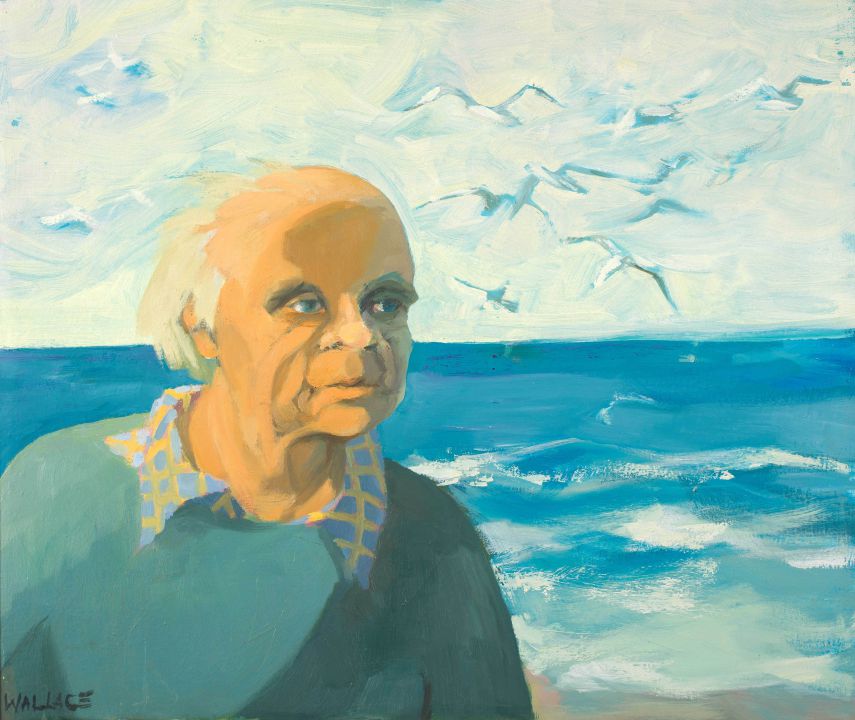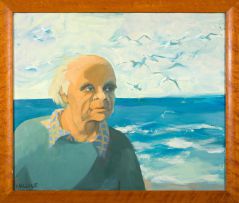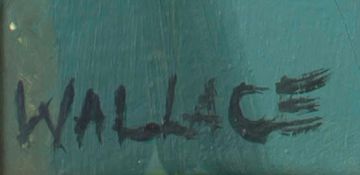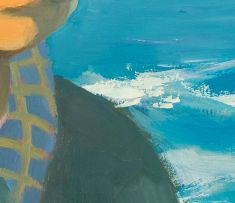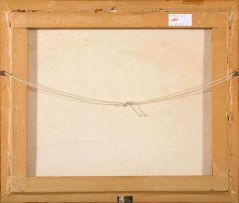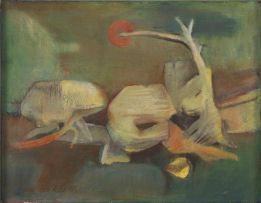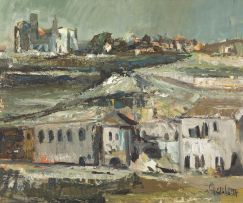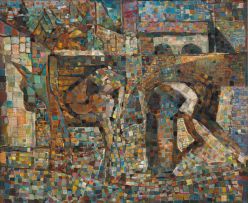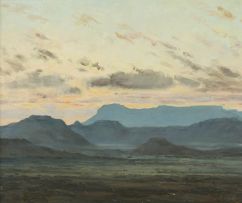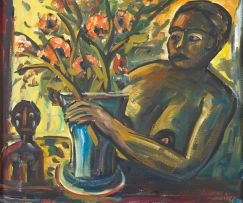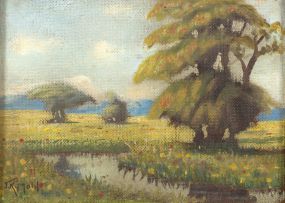Modern, Post-War and Contemporary Art, Decorative Arts and Wine
Online-Only Auction, 16 - 23 November 2020
Paintings
About this Item
signed
Notes
In the summer of 1949 Jan and Marjorie traveled to Italy. Their end destination was Abruzzi to track down Vincenzo Petrella. Petrella was the Italian subsistence farmer that in 1945 gave Uys Krige shelter and helped him to cross the mountains to reach the allied forces to the south, after Krige, that was doing service as a war correspondent during Wolrd War II, escaped from the prisoner-of-war camp at Pratola Peligna. Krige described this experience in his book "The Way Out" (1946). (The book was later published in Afrikaans as "Môre ster oor die Abruzzi" and Marjorie illustrated the dust jacket.)
Marjorie had not met Uys by then, but she recounted that she immediately felt attracted to him during this adventure to track down his benefactor and that she knew she was going to like him when she saw his photo in the place of honour in Petrella's house, next to the cross and a copy of "The Way Out".
In March 1952 Jan wrote a letter to Uys to invite him to come and visit them in Paris. On his arrival in Paris on 19 December, Jan fetched Uys at the Saint Lazare station and took him to Marjorie's studio. Marjorie and Uys immediately clicked. He was supposed to only stay with them for the weekend and thereafter find himself an apartment, but ended up staying with them for 3 months! Despite moving to a hotel in March 1953, he continued to visit them on virtually a daily basis. On Uys' departure from Paris in August, Marjorie and Jan missed him so much that Marjorie candidly confessed that she immediately did a portrait study of him from memory in an attempt to still her longing for him and keep him close to her. She never let go of this work and it had a place of honor in their house in Vermont until she eventually bequeathed it to the Document Centrum at the University of Stellenbosch. This first portrait of Uys Krige is illustrated in "Marjorie Wallace: Drif en Vreugde" (between page 128 and 129).
On his return to South Africa at the start of 1955 after seven years in Europe, Jan initially struggled to find accommodation, but found temporary shelter at Uys Krige's parental home in Draper Street, Claremont. Only in November Marjorie joins Jan in Cape Town and in December they move into the top floor of Erik Laubscher and Claude Bouscharain's house at 6 Cheviot Place, Greenpoint. After Jan bought a second hand convertible Mini Morris they regularly went to visit Jack Cope and Uys Krige at Second Beach, Clifton. At the Clifton house and Cheviot Place divergent characters met. Among the regular visitors at Cheviot Place, apart from Jack and Uys, were writers and artists such as WA de Klerk, Peter Blum, Ingrid Jonker, Kenny Parker, Richard Rive, Bartho Smit, Chris Barnard, Andre P. Brink, Ahraham de Vries, Barend Toerien, Athol and Sheila Fugard, Francois Krige, Stephen and Renée le Roux, Breyten Breytenbach, Herman van Nazareth, Nico Verboom, Peter Clarke, James Matthews, Gregoire Boonzaier, Stanley Pinker, as well as the political activists Albie Sachs and Harry Bloom.
During this period Marjorie did portrait studies of friends, including Albie Sachs, Jakes Gerwel, Peter Clarke, Ruth Prowse, Cecil Higgs and Ingrid Jonker. Initially she wanted to keep the portrait of Ingrid Jonker as a companion work to her study of Uys Krige, but following Jonker's suicide on 18 July 1965 she decided to donate it to the South African National Art Gallery.
In the anthology "In Memoriam Ingrid" Marjorie writes: "...she had the most remarkable integrity and something of the disconcerting directness of a child. It was probably that which made me like to paint her. One is always searching for people who do not wear the mask of conventional respectability, children, very old people, simple people and what I call 'real' people, like Uys Krige and, another person I like to paint, Ruth Prowse."
With the aid of a testimonial from Uys Krige and his brother-in-law Revel Fox, Jan successfully applied for a Carnegie travel grant from the American government and he and Marjorie undertake and extensive international tour from 11 June 1966 to 23 October 1969. On their return, Uys told them of a house that was for sale in Vermont, next to Onrus where he himself settled ten months before, and they settle themselves there. Following the renovations necessary to prepare a studio space for Marjorie, it is formally inaugurated on 17 May 1971, with Uys proposing the toast.
Marjorie and Jan loved Uys dearly, ever since their first encounter in Paris. Marjorie regularly had long telephone conversations with Uys more than once per day that "got lost in all kinds of labyrinths." Marjorie was regularly part of the search party for Uys' lost dentures when it typically got swept away after Uys' characteristic dive into the waves.
In his essay "Die Nimlike Uys" ("The One and Only Uys") (" 'n Boek vir Onrus" -1982, Human & Rousseau, Kaapstad) Jan describes Majorie and Uys' relationship as follows: "...she loves him more than she does me, because like all women she allows him to indulge his immense mother complex and spoils him rotten."
Marjorie took loving care of Uys until his death on 10 August 1987. Thereafter she always mentioned that she still felt Uys' presence. During her own illness and until shortly before her death she continued to have imaginary conversations with her companion Uys.
Both Jan Rabie and Marjorie Wallace's communal grave is close to that of Uys Krige.
This painting is more than a just a portrait study of Uys Krige in old age. It is testament to a lifelong friendship that stretched over almost 35 years and several locations. Although the emphatic portrait depicts Krige with his beloved ocean as backdrop, it faithfully captures his aging over the 30 plus years since Wallace painted her first portrait of him in Paris. It also accurately captures Krige's state of mind in his later years when he was largely absent from the present and preferred to live in only in his past, as described in Jan Rabie's essay "Die Nimlike Uys" ("The One and Only Uys") (p 111, " 'n Boek vir Onrus" -1982, Human & Rousseau, Kaapstad).
Bronne/ Sources:
"Marjorie Wallace: Drif en Vreugde" - Amanda Botha, 2006, New Africa Books (Edm.) Bpk., Claremont
"Die Goue Seun - Die Lewe en Werk van Uys Krige" -J.C. Kannemeyer, 2002, Tafelberg Uitegewer Beperk, Kaapstad
https://en.wikipedia.org/wiki/Uys_Krige
https://en.wikipedia.org/wiki/Marjorie_Wallace_(artist)
Die Sestigers: An Online Exhibition curated by Kylé Pienaar (https://diesestigers.wordpress.com/)
